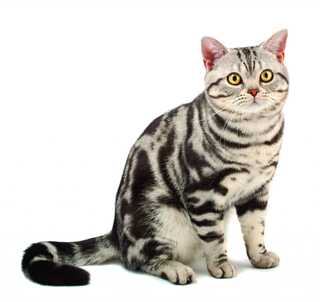
Note: While the breeds in this collection tend to be calico, individual pets will vary. Please consult the adoption organization for details on a specific pet.
If you’re wondering, “What is a calico cat?”, you may have noticed them without realizing it. Calico refers to the striking blend of orange, black and white coloring of a cat’s coat (although variations of these colors also occur).
Wondering if a calico cat will make a good addition to your household? Whether you’re looking for adult felines or calico kittens, here’s what you should know about a calico cat’s personality, temperament, lifespan and other traits.
What Are Calico Cats?
The term “calico” is used to describe a triple-colored domestic cat with white, orange and black fur. It doesn’t refer to a specific breed.
The coloration is the result of a genetic phenomenon called X-chromosome inactivation. In short, if a cat’s X chromosome—which determines their fur color—is inactivated, their color may change from, say, black to orange (or vice versa). The inactive chromosomes are random, so each calico’s coloration is unique.
Because of their special gene sequence, almost all calico cats are female.
Historically, calicos can be traced to Egypt, as well as port cities along the Mediterranean Sea.
What Does a Calico Cat Look Like?
A calico cat’s fur is orange, black and white. The colors appear in independent patterns, rather than swirling together.
Calico patterning is different for every cat. For example, one may have an all-white muzzle while another’s face has black and orange spots with only a little white.
A calico feline with less intense coloring is known as a muted calico or dilute calico. The colors may appear faded or, in some cases, will vary from more common colors. A dilute calico can have cream or light red patterns on their coat.
Additionally, a gray calico may have a more subdued (but similarly eye-catching) appearance.
Because calico coloring isn’t breed-specific, other characteristics of your pet’s appearance depend on their individual breed. For example, there are longhair calico cats as well as those with short hair.
Types of Calico Cats
Many types of cats can have calico coloring. That said, here are some more common calico cat breeds:
Calico Cat Temperament & Behavior
Calico cat behavior has more to do with breed and an individual’s personality than its coloring. However, some pet owners believe calicos to be energetic, confident and sweet. While they can be independent and resist frequent attention, they may also form strong bonds with their owners.
Are All Calico Cats Female?
Almost all calico cats are female. Their unique tricolor blend is a result of a special combination of chromosomes. Calicos need two X chromosomes—one carrying the genetics for black coloring and one for orange. With rare exception, only females can have XX chromosomes.
Additionally, you can’t breed calicos to get calico-colored offspring. The coloring happens only by chance.
So, if you’re wondering, “Why are calico cats female?”, it’s due to their unique genetics, rather than a result of breeding.
How Long Do Calico Cats Live?
A calico cat lifespan matches that of most cats—between 13 to 17 years. This may vary depending on breed, whether your feline is an indoor or outdoor cat, and specific health conditions.
Where to Adopt a Calico Cat
Maybe you’re drawn to their noteworthy coloring or perhaps it’s their quirky personality that interests you. Regardless, calicos can make great feline companions.
To get started, search online to adopt a calico cat by completing Petfinder’s pet adopter profile. This connects you to a large database of animal shelters and rescue organizations.
Whether you’re interested in calico kittens for sale or an adult tricolored cat, you can find your future pet through Petfinder.
Frequently Asked Questions About Calico Cats
How Rare Are Male Calico Cats?
Male calico cats do exist, but they are rare. It’s estimated that one out of every 3,000 calicos are male. This is due to an uncommon sequence of chromosomes.
Male felines typically have an X and Y chromosome. Occasionally, though, they may have an XXY sequence, resulting in calico-colored fur.
Unfortunately, the extra X chromosome causes a health condition known as Klinfelter’s Syndrome, which is associated with developmental, cognitive and behavioral problems. A male calico cat is also sterile.
Do Calico Cats Have Health Problems?
There are no known health issues associated with female calico cats. Rather, their health depends on factors such as breed, diet and lifestyle. As with any type of cat, make sure your calico is regularly seen by a veterinarian to keep them healthy.
Tortoiseshell Cat vs. Calico: What’s the Difference?
Calico cats are sometimes confused with tortoiseshell felines (a.k.a. ‘torties’). They have similar coloring and are usually female. There is one key differences, however.
While calicos and torties can have orange and black patterns on their coat, torties don’t have white fur. Also, calicos’ colors are often more defined and independent from each other.
These felines can seem more alike than different (at least superficially), which is why the ‘calico cat vs. tortie’ question is understandable.
Are Calico Cats Considered Lucky?
Over time, calico cats acquired a reputation for being a source of luck. In Japan, they accompanied sailors on their ships because they were thought to provide protection from the sea, as well as apparitions of ancient ancestors.
Do Calico Cats Have Special Dietary Needs?
Calico cats have the same dietary needs as other healthy felines. Barring any health conditions, they should be fed complete and balanced cat food formulated for their age and lifestyle.
What Are Some Names for Calico Cats?
The unique coloring of calicos may motivate you to give your pet an inspired name. Whether it’s food-related, celebrates their color and personality, or honors their Egyptian heritage, here are some potential calico cat names:
- Butterscotch
- Toffee
- Honey
- Patches
- Copper
- Rebel
- Moxie
- Blaze
- Cleopatra
- Nefertiti
Explore more cat breeds and find your perfect feline companion with Petfinder.





